Reptile & Amphibian
News Blog
Keep up with news and features of interest to the reptile and amphibian community on the kingsnake.com blog. We cover breaking stories from the mainstream and scientific media, user-submitted photos and videos, and feature articles and photos by Jeff Barringer, Richard Bartlett, and other herpetologists and herpetoculturists.
Monday, August 31 2015
By
Mon, August 31 2015 at 10:20
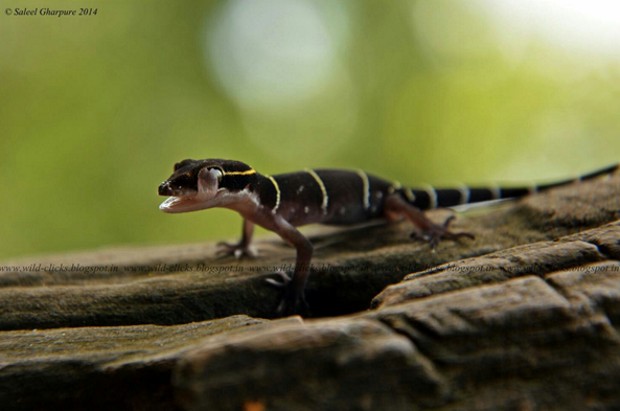
It was my first herping adventure and one of the best memories in my herpetology career. I am a snake-researcher but I also have to accept the fact that I belong to the society of herpetologists and also need to accept whatever Mother Nature throws at me. The Deccan banded Gecko or Deccan Ground Gecko Cyrtodactylus deccanensis was one of the gifts of Mother Nature which I happily and enthusiastically accepted.
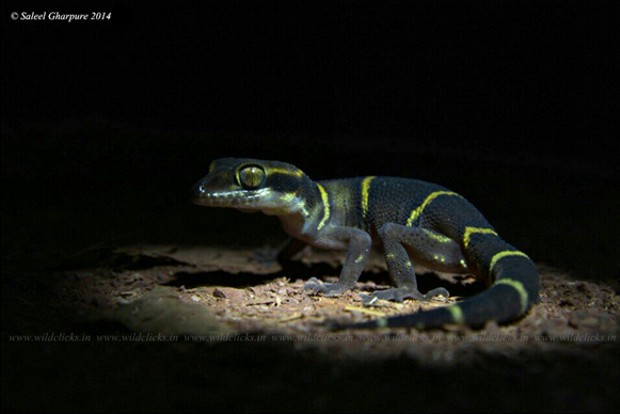 This reptile is commonly found in out-skirts of my area. Looking at the pictures of these creatures one couldn’t but stop themselves to admire the unique beauty of these lizards. The color pattern of these geckos is simply amazing, the body is reddish-brown with thin yellowish white bands and the average size of this gecko is 2.25cm.
Whenever you set out for herping adventure, you never know what you are going to encounter, sometimes your wishes are fulfilled and sometimes you return empty. As it was my first herping trip I was expecting to see some snakes but I ended up finding just a lizard, a beautiful lizard, and the best part was that I found something new.
Photo: saleel gharpure
Friday, August 28 2015

"There' one!"
I slammed on the brakes, pulled a 180, and sped back to--to another rock. Another 180 and we were moving westward again. The last "turn" had brought the false sightings up to Five. Five times we had thought we had sighted a round-tailed horned lizard, Phrynosoma modestum, basking on the pavement and five times it had been a rock or a piece of flattened vegetation.
I had about brought the old car back up to 65 mph when Jake screamed again. This time I didn't turn, I merely stopped at roadside and told Jake "Go get it." He hopped out, ran back a couple of hundred feet, and stooped to pick up another "rock." But unless he was taunting me he usually didn't pick up rocks. Maybe--just maybe...
By the time Jake had returned to the car he was grinning from ear to ear. That last "rock" actually was the horned lizard we (and especially he) had wanted so badly to see.
We had failed to find a round-tail on the first 10 of the 12 days allocated to this 2015 trip to the Big Bend and had begun to wonder whether 2015 would replicate 2014's trip when we had not found the species. We no longer had to wonder. Success, finally!
Now to find my camera.
More photos under the jump...
Continue reading "Round-tailed horned lizards at last!"
Thursday, August 27 2015
By
Thu, August 27 2015 at 14:27
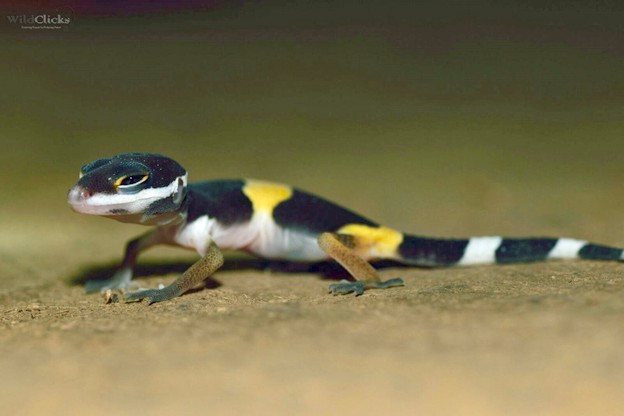
Most of the time during my herping trips if I spot lizards I usually tend to ignore them, but if it is some unique or beautiful lizard I make sure to mention them in my blogs. So today I present you one of the most beautiful reptiles from India, the Leopard Gecko Eublepharis macularis.
The Leopard Gecko is a ground dwelling lizard found in India and also in Pakistan, Afghanistan and some parts of Iran. Leopard Geckos spend most of their time in burrows during the day. They become active at dawn and dusk when the temperature is favorable, so they are mostly nocturnal. These geckos are called leopard geckos because of their coloration, an adult leopard gecko having spots on its body like a leopard. I find the juveniles more beautiful than the adults, having a black body with thick yellow and white bands on it. These geckos primarily feed on crickets and earthworms and the size varies from 20-27cm.
I always prefer to maintain a distance from lizards because I am a bit scared of them but if there are such beautiful species like leopard gecko, they always fascinate me.
Photo: Saleel Gharpure
Tuesday, August 25 2015
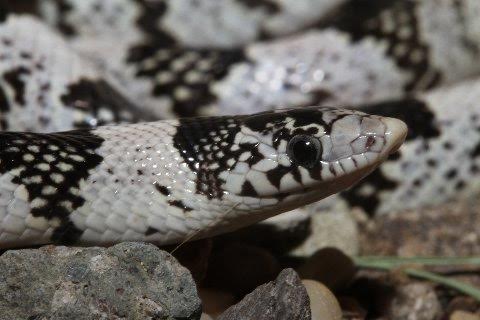
It had been a very long day in West Texas, and it was past time to call it quits. Jake and I had just driven almost non-stop from our Florida homes and following an hour of shuteye had hit the road for a little r&r (herping). We had done pretty well, photographing a pretty male Baird's rat snake at road edge and an equally pretty mottled rock rattler on a roadcut before changing venues.
Now, at 3 in the morning, we had decided to call it a night and had headed back for the motel when a ring-tailed "cat" at roadside caught our attention. I slowed to watch the little mammal and was just speeding up when we saw a solfugid (sun spider) on the yellow center line. Photo time. As I stepped from the car I noticed a small snake that was lying quietly on the center line only a few feet from the solfugid. Immediately recognizable as a long-nose, Rhinocheilus lecontei, the little snake was as obviously different as it was recognizable -- it lacked even a vestige of the red pigmentation so typical of the species. It was merely black and white, anerythristic if you prefer.
What a great find at the end of a long and busy day.
More photos under the jump...
Continue reading "An aberrant long-nosed snake"
Monday, August 24 2015
By
Mon, August 24 2015 at 00:07
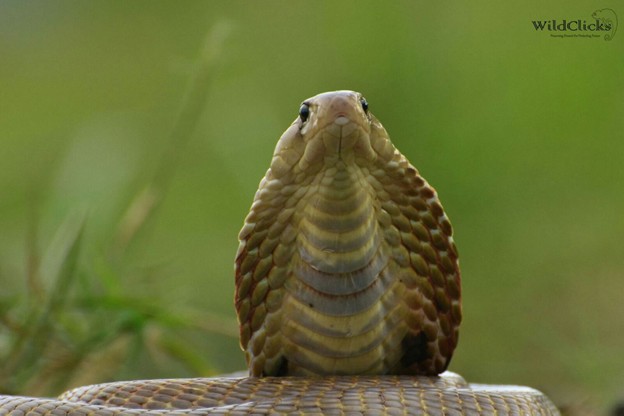 While India is technologically well developed in urban areas, it is also a country dominated by many superstitions regarding it's beautiful gifted and diverse fauna.
Nagpanchami, an Indian festival very true to its name, is celebrated to worship the Nagas, or Cobras, as these creatures have a great significance in Indian mythology. Strange but true, as a part of the worship ceremonies, cobras are offered milk, as well as a variety of spices, which is not food for cobras, in fact any snake in the world. At times, devotees are seen pouring bowls of milk over the snake’s head, and sprinkling the head with haldi (turmeric), kumkum (saffron) and other powdered spices that form the worship rituals. The milk and the different spices enter through nostrils into lungs often causing a slow and painful death.
These religious ceremonies are difficult to stop because people have been following them for centuries, even though they have been outlawed.It's my feeling that people don’t worship them because of the spiritual connection, they worship it out of fear, the fear of getting bitten by Nag.
Photo: saleel gharpure
Thursday, August 20 2015
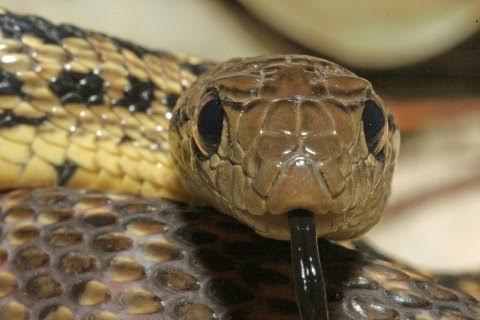
Having kept and bred Santa Cruz (Channel Island) gopher snakes, Pituophis catenifer pumila, for several years, I had become enamored with this smallest of the gopher snakes. Even though these snakes are of nervous demeanor and have an occasional tendency to huff, puff, and strike, their 28 to 34" adult size makes them an easy gopher snake to handle.
Restricted in range to two of California's Channel Islands (Santa Cruz and Santa Rosa Island) there seems to still be a paucity of information on this snake's preferred habitats. However, it is probable that like other forms of the gopher snake, the Santa Cruz subspecies is a habitat generalist that utilizes most if not all of the varied insular habitats--be they montane, pastoral or littoral.
The entire range of the Santa Cruz gopher snake is now under the protection of the National Park Service and/or The Nature Conservancy. Therefore this tiny gopher snake can be difficult to acquire.
And how tiny is "tiny"? As mentioned above the adult length seldom exceeds 30" and hatchlings are 6 to 8" in length. For a gopher, that's tiny!
More photos under the jump...
Continue reading "Santa Cruz gopher snakes"
Wednesday, August 19 2015
By
Wed, August 19 2015 at 00:00
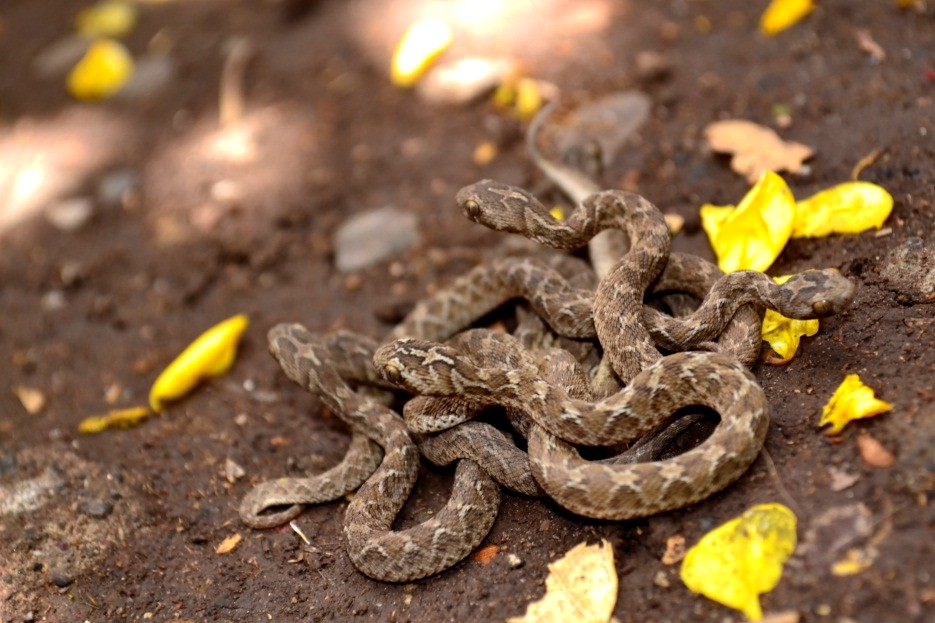
This was a time in summer when I as usual was free and always ready to go herping. Diveghat is half an hour away from my house where before the dawn deer were spotted and every Sunday I rode there in the hope to see something new. That day I was lucky enough to encounter something.
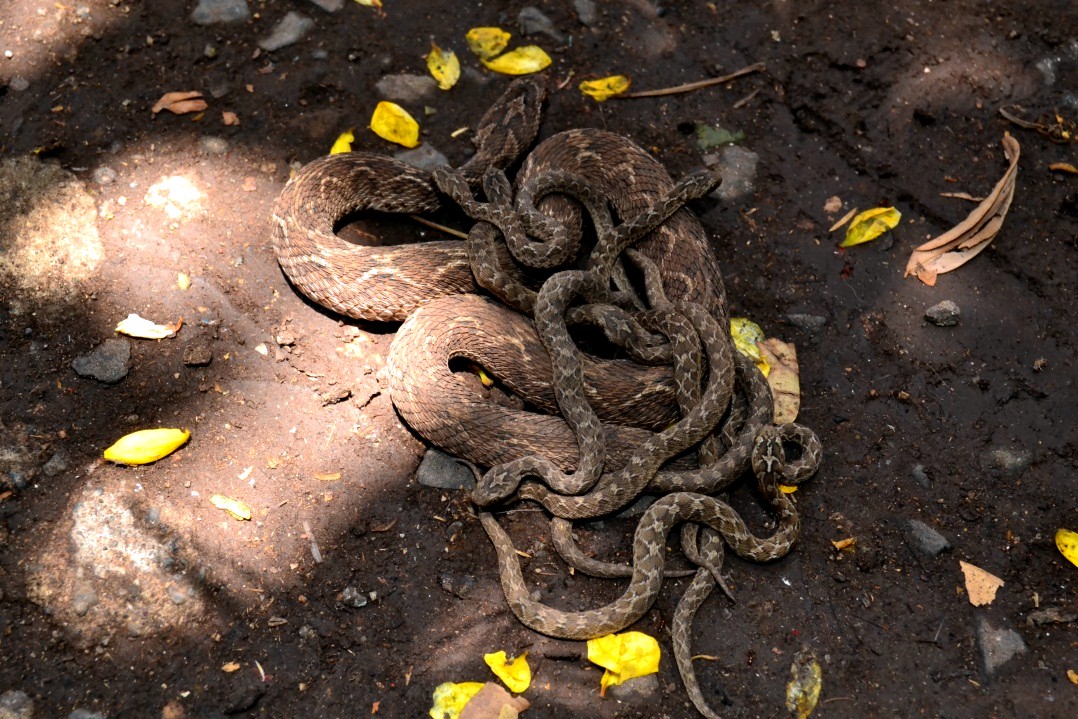 So as usual I arrived at the place, saw some deer and started with my search for scorpions and saw-scaled vipers. The best part about herping in this place is that you don’t need to observe the bushes or enter in a dense forest, the only thing you need to do is check under small rocks by lifting them so this makes your herping a bit easier.
In the beginning I found a couple of scorpions and centipedes but I had a feeling that some bigger surprise is waiting for me. Within half an hour I encountered one of the bright spots of my herping, a healthy female saw-scaled viper with her six young ones. What a moment of happiness, can’t define that happiness in words. After seeing this family I was completely refreshed, the tiredness vanished within seconds. We clicked some beautiful pictures and left them. I wanted to take all of them home and nurture them but couldn’t do so because after all it was mother nature’s belonging.
Photo: riyaz khoja
Tuesday, August 18 2015
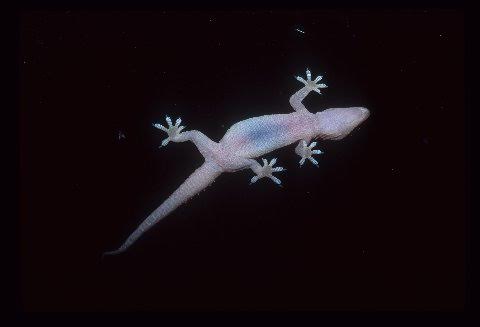
Patti and I sat on the screened deck this evening (06/03/15) and marveled at the agility of the many bats (probably most were Mexican free-tailed bats) and several dozen dragonflies overhead. We were in the midst of a flying ant emergence and the predatory insects and bats were taking full advantage of the seasonal repast. On convoluted flyways some 30 or 40 feet up, both had become active while the sun was still visible on the western horizon and were still wheeling and reeling when it became too dark to follow their aerial antics.
I came inside to make a few notes on the sightings and happened to glance around at the windows. Not only was it a bat and dragonfly night, it was a gecko night as well. There was at least one Mediterranean gecko, Hemidactylus turcicus, on every single window and several windows hosted 2 or 3 geckos. Every gecko was actively foraging on the ants and other small insects drawn to the lights.
The temperature was a warm 81F and the humidity 85%, apparently providing ideal conditions for our nocturnal friends. And I noted that the dragonflies, insects I had always thought of as exclusively diurnal, were still active when it had become too dark for me to follow their antics. This had been better than watching the Blue Angels and a whole lot less noisy. Some evenings just can't be improved upon.
More photos under the jump...
Continue reading "Bats, dragonflies, and geckos"
Monday, August 17 2015
By
Mon, August 17 2015 at 00:00
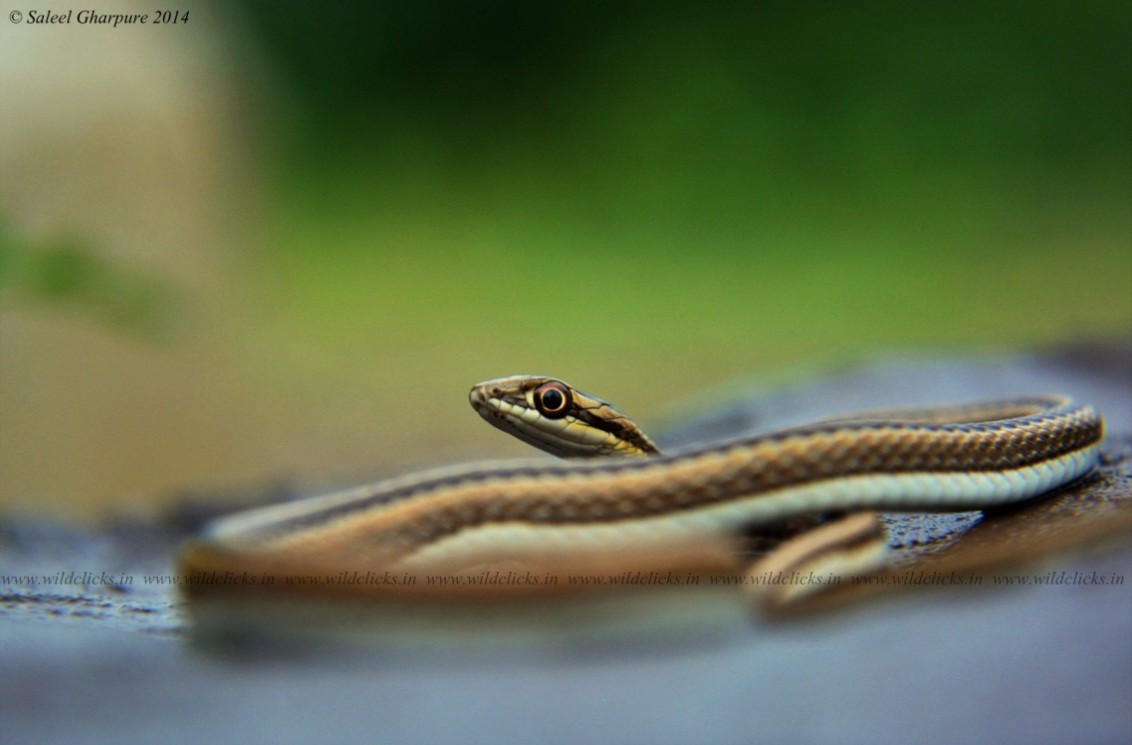
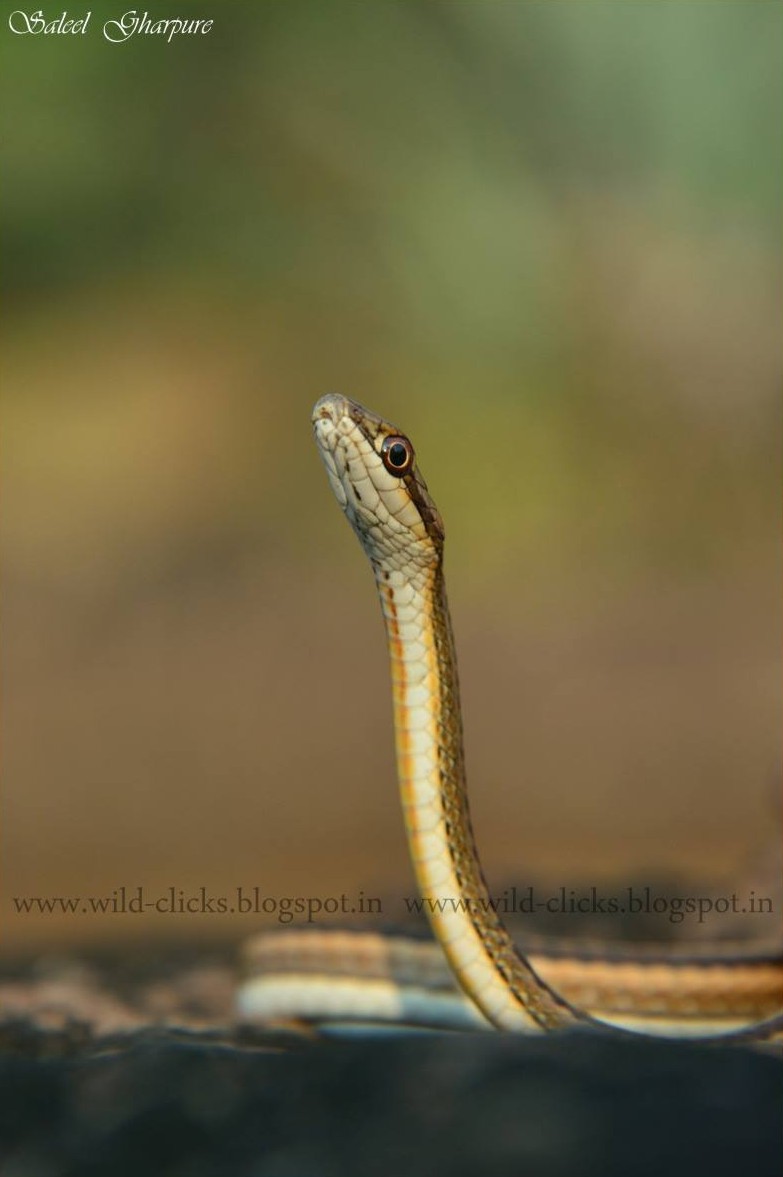
The day when I purchased my first book of snakes and reptiles and saw the picture of Leith’s sand snake Psammophis leithi , I paused for a minute and stared at the picture for a while and I felt in love with this stripped reptilian fellow. Whenever I used to meet any new snake rescuer in my area, one thing which I used to tell every new rescuer I met “dude if you rescue a Leith’s sand snake, please call me” and finally I got to see one.
The Leith’s sand snake is a semi venomous or rear fanged snake found in India and luckily also found in my state Maharashtra. The reason I like this snake so much is because of its insane color pattern, It has a light brown slender body with dark brown or dark grey stripes on the upper body. If I describe the color pattern in my words I would rather say "a slender rope made of gold with 4 horizontal black stripes painted on it". These snakes mainly feed on rats, lizards and small birds. The maximum length of this snake is 80cm and it is oviparous by nature, lays 3-12 eggs.
I won't say that these snakes are the most beautiful snakes of India but I would definitely call this one “the attention seeker”.
Photo: Saleel Gharpure
Thursday, August 13 2015
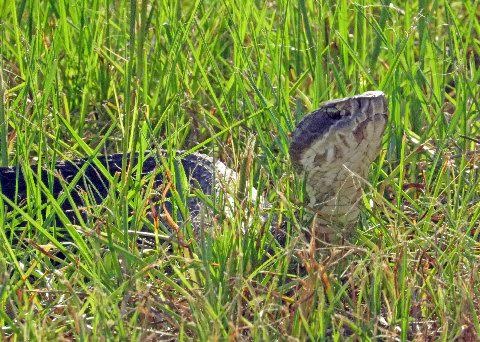 It was early morning (about 0715) and the temperature was just about 70 F. A least bittern -- always an avian photographic nemesis for me -- had just flown across the gravel road and landed in a patch of cattails about 30 feet ahead of me. I slowed, not that I was walking all that fast anyway, and decided to sit and wait a while on the wet and grassy bank to see if the bird would emerge in a photographable position. It did. But hoping for something even better I waited longer.
As luck would have it, while waiting I noticed a slight disturbance in a patch of floating vegetation about 15 feet from shore. My interest shifted to the floating grasses. Was something really there or was the disturbance caused by a current? I watched. Yes, there definitely was something there and it was closer to shore now. Ah ha! A snake. A dark snake with vestiges of darker bands and of a fair girth. Oh, of course. A Florida cottonmouth, Agkistrodon piscivorous conanti.
The snake neared the shore, idled quietly in the shallows for a minute or two, then slowly emerged. It angled towards a sunny spot about 6 feet from me. Once there it stopped with its head bathed in the warming rays, and then with tongue flickering coiled ever so slowly. When I shifted positions to better angle the camera the snake made a fleeting defensive gape.
Once it settled, I stood, moved quietly up the hill, and left both bird and snake in peace. This was a fine way to begin the day.
More photos under the jump...
Continue reading "Bitterns and cottonmouths"
Wednesday, August 12 2015
By
Wed, August 12 2015 at 00:00
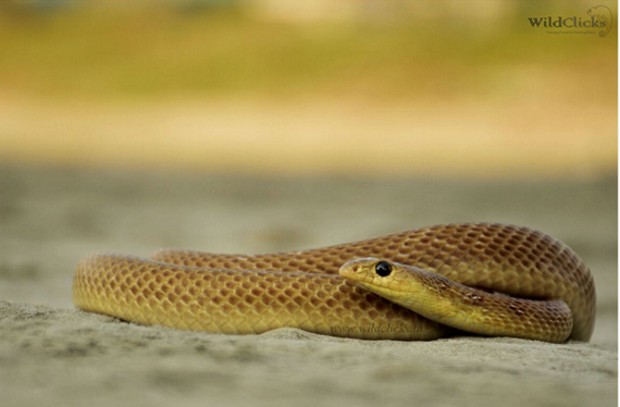 As far as snakes go, the racer is in large found on the African and American continents, but racers also commonly found in the suburbs of India. These snakes are common enough that I should have written about racers earlier, but due to lack of photographs I wasn’t able to do so. Luckily my dearest friend Saleel Gharpure shared his photo with me for my blog post.
The Banded Racer Argyrogena fasciolata possesses white bands on it when young but the bands fade and become less obvious as it matures. Adults of this species end up entirely light or dark brown. The maximum size of these non-venomous snakes is 4-5ft and it is oviparous by nature, it lays 5-12 eggs between February and April. And as the name implies, they are very fast.
I have rescued these snakes a lot, many times on rescues these snakes disappear before I reach the rescue spot because of their speed. If they are in an open space and I try to go near them, I am sure they will disappear within seconds in front of my eyes. But, worryingly, that these snakes are slowly slowly declining in my my area It has been 8-9 months since I found this racer on a rescue, but I am sure I’ll encounter another of these magnificent creatures very soon.
Photo: saleel gharpure
Tuesday, August 11 2015
The skies opened and the deluge began. There was no easing into it. Within minutes, the afternoon sun in which anoles and tortoises had been basking had been obliterated by leaden clouds. Thunder rumbled and lighting speared the heavens. Torrential rains were falling - 2 and a half inches in just under one hour.

By the time darkness had enveloped us, our little artificial pond on the hill was freshened, overflowing, and echoing with the rapidly pulsed and oft repeated trills of southern toads, Bufo terrestris.
But it was from across the road in the newly opened Sweetwater Wetlands Park that the true anuran cacophony had begun. Tiny marble-sized narrow-mouthed toads, Gastrophryne carolinensis, were present in some numbers, but their peenting calls were virtually overwhelmed by the vocalizations of the two larger, dominant treefrogs: the green and the barking ( Hyla cinerea and H. gratiosa, respectively) that had gathered by the dozens, perhaps in the hundreds in the newly created temporary pools.
With favorable breezes the loud choruses, the "wonks" and "hollow barks", of these 2 beautiful hylids could be heard from our back deck more than a half mile away.
Need I mention that it is for these storms that we wait anxiously each year, for with each year's storm arrival we are enchanted anew by the anuran activity they induce.
Monday, August 10 2015
By
Mon, August 10 2015 at 00:30
I think I really don’t need to describe how much a snake lover is fascinated by albino snakes because, all my reptile lover friends reading this blog know that awesome feeling very well when we see an albino snake. 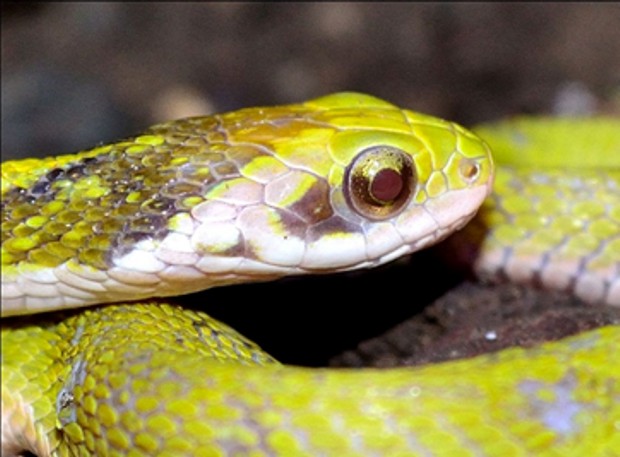
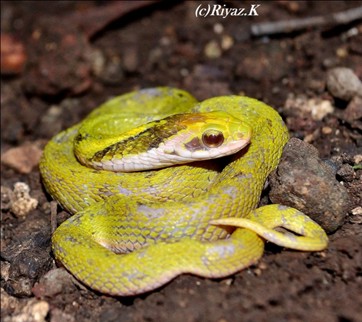 In a country like India, where you can’t keep reptiles as pets, it is very rare for a snake lover like me to see an albino snake or else you really need a ‘strong luck’. As I said strong luck, I still can’t believe I was so lucky for a while when I saw this beautiful snake.
It was 2012 and my friend had rescued a snake and he decided to give me a surprise, so he called me up and said “Sachin I have rescued a cobra so come to my place we’ll go and release it”.
When I reached his place I asked him to show the cobra and he showed me the jar, when I closely observed the jar and literally shouted “WTF is it an albino grass snake?” Yes! It was an albino green keelback Macropisthodon plumbicolorwhich I was sure when I regained my senses after going crazy.
I am very thankful to that friend for doing me such a big favor. I called my friend Riyaz Khoja to click this beauty and as usual Riyaz is always at his best for capturing amazing shots. I really wish my life gives me such moments again and again where I can call myself lucky.
Photos: Riyaz Khoja
Friday, August 7 2015
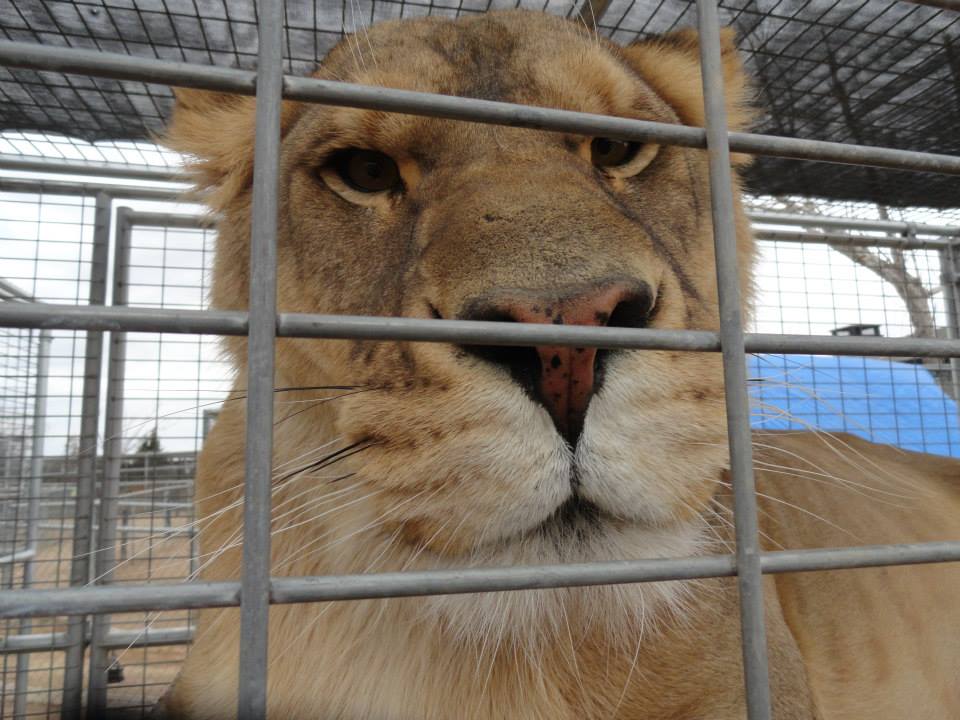 For the past 2 weeks Milwaukee WI has been under siege with a rumored lion running wild on the streets. As yet only one video has emerged of the lion that is plausible and the media and police blotter are reporting different things. Adult female African lion, Juvenile male African Lion, adult Mountain Lion, some even report cubs being present.
You might be asking yourself, as a reptile keeper, who cares about a stupid lion! What does this have to do with me? When regulation rears it’s head reptiles are usually lumped in with big cats and primates, and Wisconsin is one of the few states that does not currently have extensive exotics legislation at the state level. That is for now.
The Humane Society of the United States working with politicians are crafting legislation soon that will likely parallel the strict regulations introduced in Ohio after the Zanesville tragedy.
According to Wisconsin State Sen. Van Wanggaard in an interview with WISN Milwaukee:
“This bill would codify exotic animals as being something that would not be allowed to be owned in personal residential areas,” Wanggaard said.
...
He said that people who currently own exotic animals will be grandfathered in until the animal dies, but they would have to register the pet and get a permit.
Of course to really push the law, they need the lion and that will means more than a grainy video. The Milwaukee Police Department however is running the search and with other more pressing priorities, most Milwaukeeans doubt they have the ability to actually capture a lion, if it really exists.
Supporters of the bill, including Van Wanggaard, are hopeful they will have the law in place by the end of the year. Reptile keepers however are preparing for a long battle.
Inset photo is of Gypsy, an adult female lioness under the care of Forever Wild Animal Sanctuary in California.
Thursday, August 6 2015
"Snake!" Both Jake and I voiced the single word simultaneously.
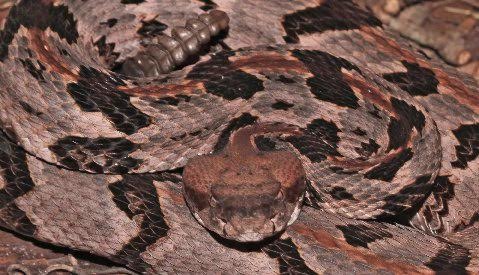
Ahead of us, nearing the edge of the pavement, was the unmistakable form that we had been hoping to see. There were no other vehicles in sight on the roadway. As we neared, we both said "canebrake." I stopped a couple of dozen feet before reaching the snake and Jake piled out of one door and I from the other. The snake lying quietly stretched out, merely kinked a bit as we neared and never rattled.
The canebrake rattlers, Crotalus horridus atricaudatus, of this region vary noticeably in ground color with most being tan or dead-leaf brown. A few, though, are a beautiful purple or pink and we were elated to see that this 30 incher was one of these latter.
Since there was still no traffic we took a few pictures, gently touched the rattler's tail with a slender stick, and watched for a few moments as the snake slowly crawled from the pavement and disappeared without disturbance into the roadside greenery.
A canebrake had been our goal for the evening but having found this beauty we decided to continue road-hunting for another half hour. In that 30 minute time frame we saw 3 additional snakes: a corn, a juvenile yellow-gray rat snake, and a Peninsula ribbon snake.
All in all it was a great evening, one that we both would remember favorably, and we were home before dark!
Wednesday, August 5 2015
By
Wed, August 5 2015 at 05:53
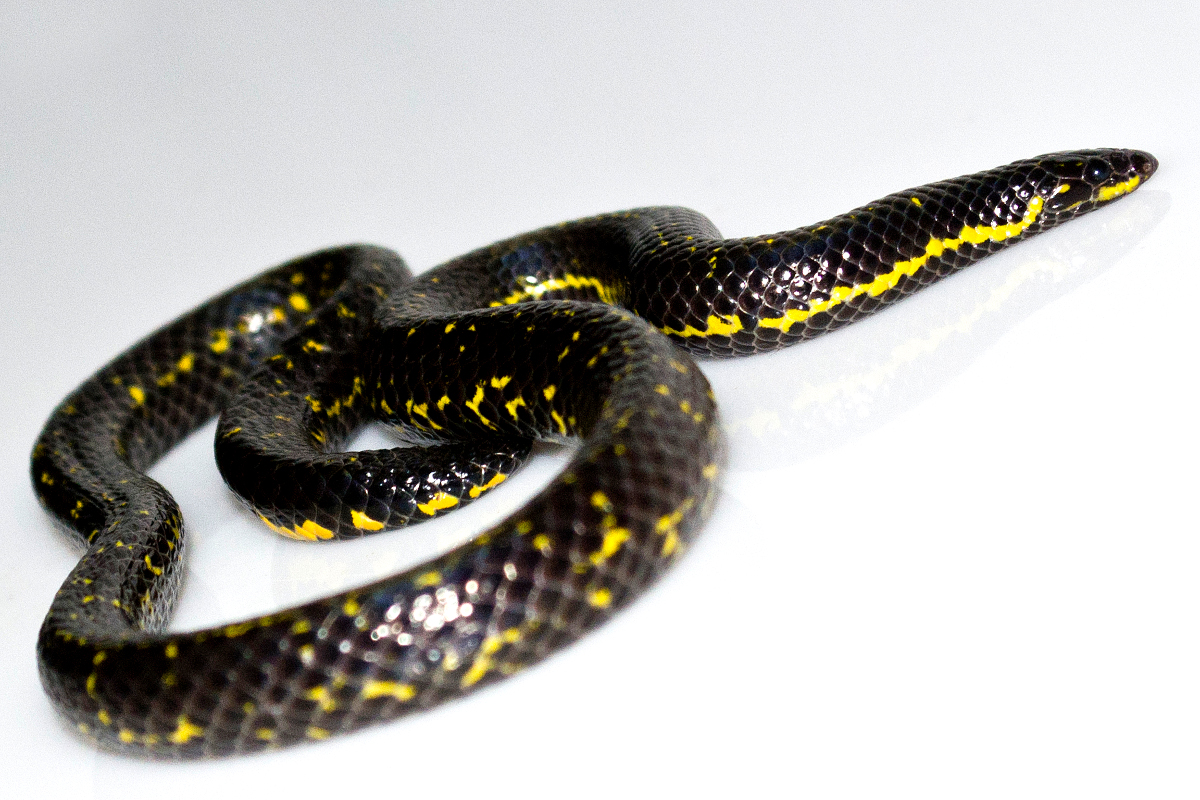 India is a land of vast number of reptiles and as I have been writing and researching about them, I would definitely say I am fortunate to be part of a country where Mother Nature has showered such a tremendous number of its beautiful creation. Another beautiful gift by Mother Nature to India is the Phipson’s shield tail, Uropeltis phipsonii.
For many non-Indian readers, it may seem to be a new fellow. The name of this non-venomous snake symbolizes its tail, which seems to have a sliced tail, strange but pretty amazing! While examining them I came to know that these snakes are short with the maximum length of 28-30cm, and mainly dine on earthworms. The most interesting fact about them is that being so tiny, these snakes are viviparous and give birth to 5-7 young ones at the onset monsoon.
It’s always a pleasure to meet these snakes on herpings and trekking’s but the sad part is that these snakes, being so harmless and sensitive, are the major victims of road kills. It’s a very disturbing truth for a reptile lover, but the fact is nobody can be blamed in such circumstances because unlike other snakes, shield tail snakes are heard to spot and thus fall victims to cars.
I would like to conclude by saying be alert while driving. This will not only benefit you but also protect the environment. As we always say, "Brake for snakes."
Photo: Ryaz Khoja
Tuesday, August 4 2015
I was a few steps ahead of Patti walking that mid-May evening on a trail in the newly opened Sweetwater Wetlands Park. My nose in the air, I was looking for a nearby white-eyed vireo that was caroling loudly and persistently from the low trees.
Suddenly Patti said "You better stop and look at what you just walked by."
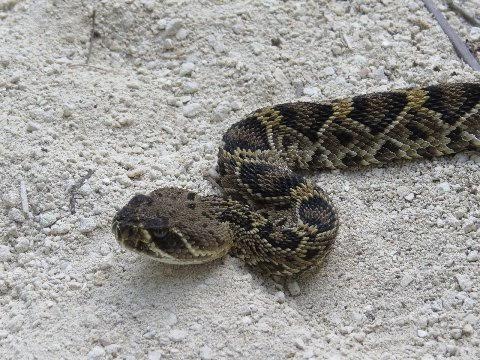
I stopped, turned and looked down. About 10 feet behind me, lying unperturbed by my passing and our presence, half its 30" body length on the path, was a beautiful juvenile eastern diamond-back rattlesnake, Crotalus adamanteus.
Stretched fully out and except for its flickering tongue and lying absolutely motionless, the little snake had just left the woodland and begun crossing the trail. With other folks approaching, we decided it would probably be best to move the little snake out of sight.
Picking up a slender stick I slid it beneath the snake and moved him to the side of the path. Within seconds he had completed the effort and moved quietly and completely from view.
We happily bade it adieu.
Monday, August 3 2015
By
Mon, August 3 2015 at 05:53
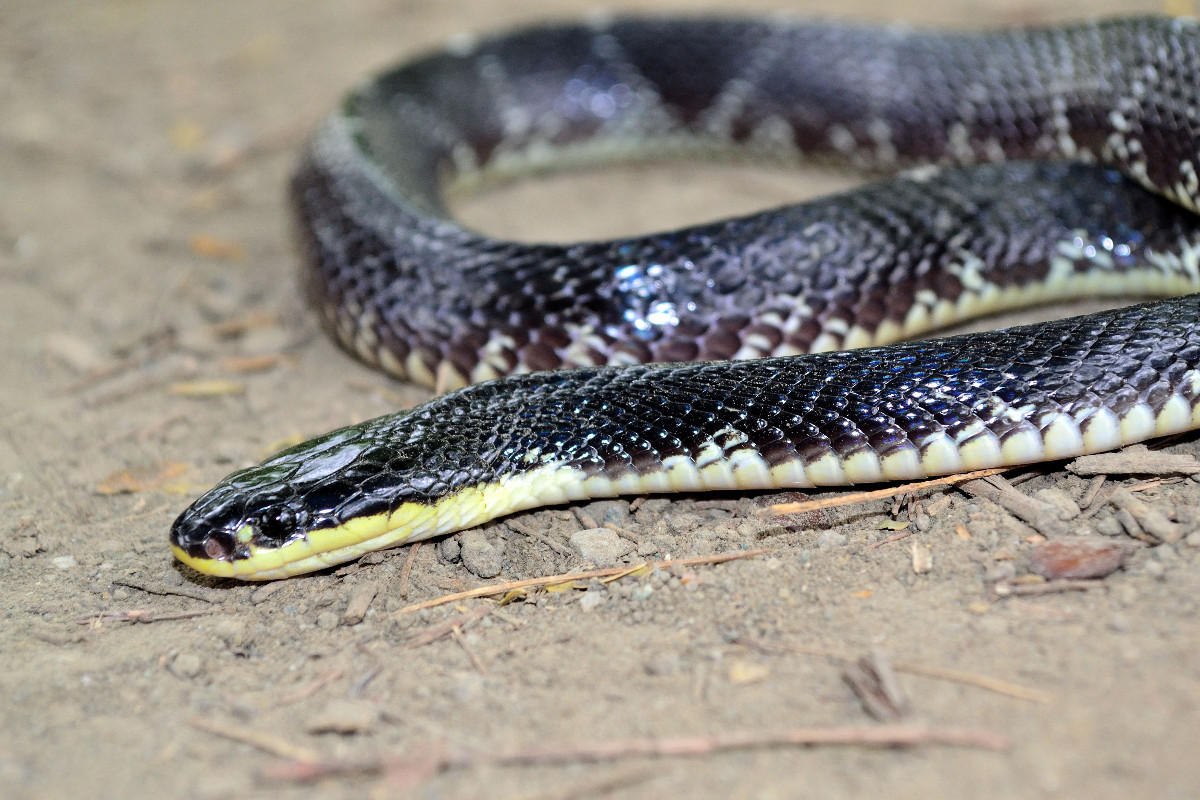 The krait, a venomous snake I consider to be one of the deadliest creatures on our planet, is widely spread on the Indian subcontinent, where nine species of krait can be found. I love kraits because of their behavior and their color which is dark shiny black with thin bands of white dotted spots.
I have already written in one of my previous blogs about the common krait, bungarus caerulus, and explained why it is known to be deadly. Now I would like to write about the next member of the krait family, which is also luckily found in my city.
The Wall’s sind krait, bungarus sindanus walli,is a species of a krait with almost same features of a common krait. The best way to differentiate between these two kraits is, the Wall’s sind krait has a yellow lip and throat while the common krait has white. The maximum length of Wall’s sind krait is 5ft and it mainly feeds on other snakes, including cobras and other kraits.
I have rescued this snake only once because it is found in the outskirts of my city and rare to find during the day. Experts say this snake is more aggressive and prone to bite than the common krait. However, kraits are always attractive to me, and whenever I look at the Wall’s sind krait, its beauty makes me feel that a common krait has applied a yellow lipstick.
Photo: Riyaz Khoja
|



